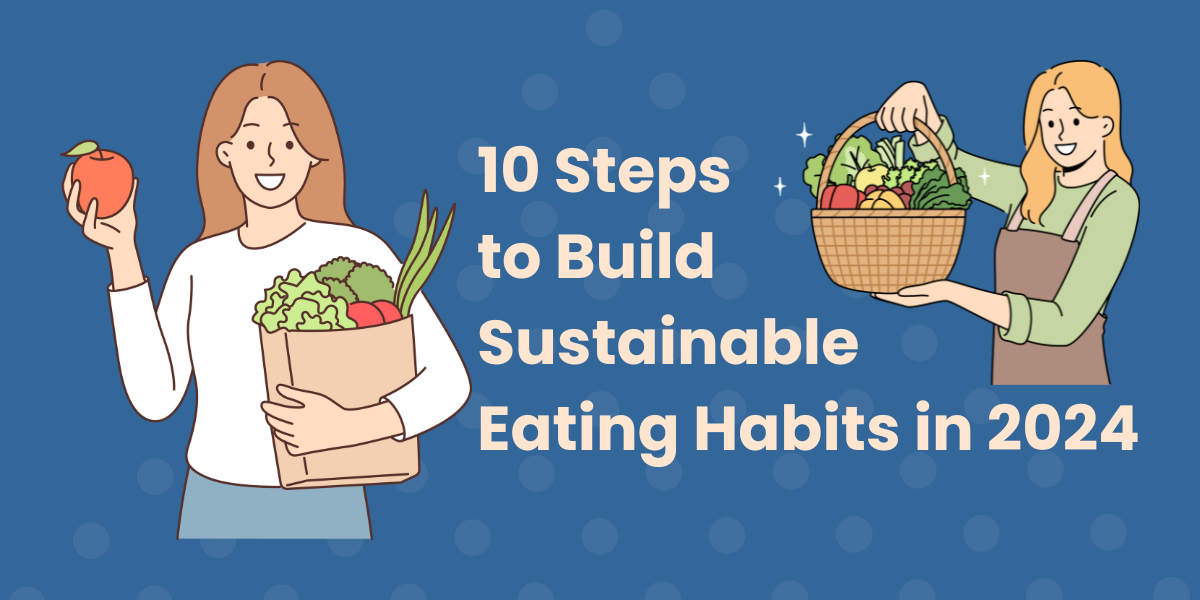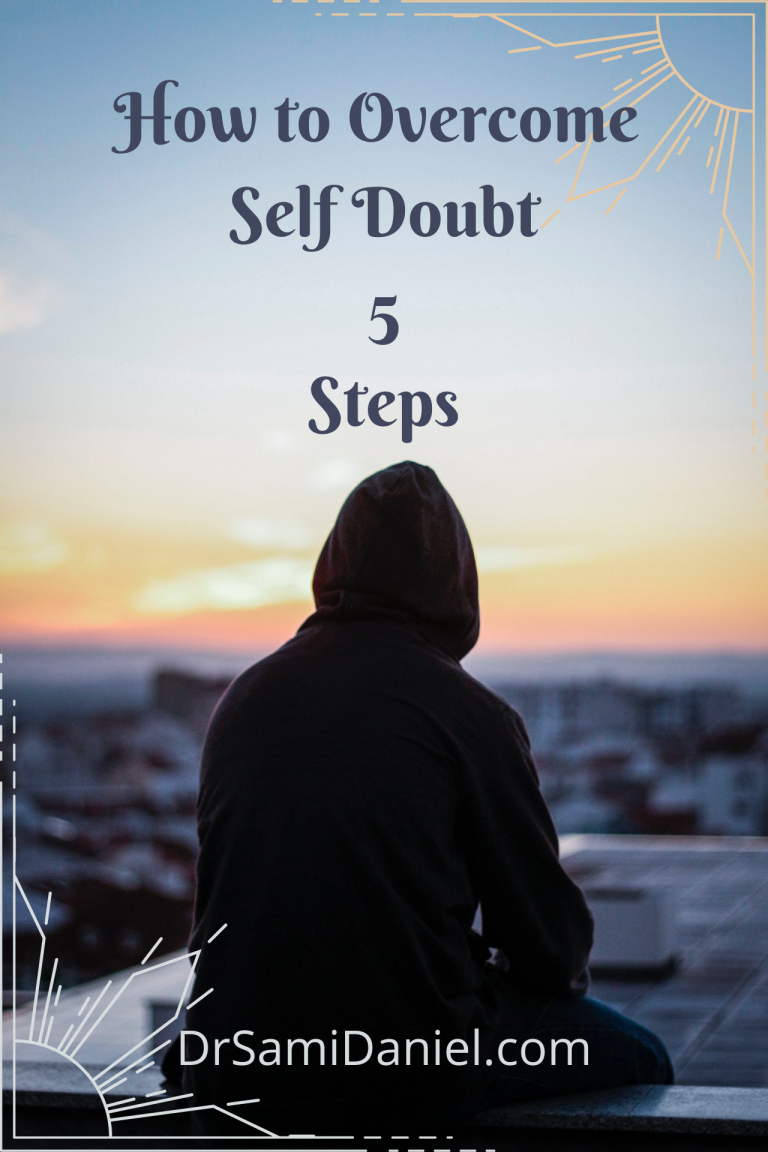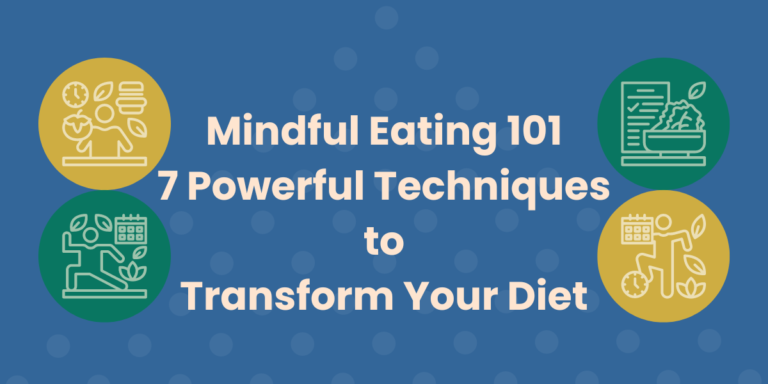10 Steps to Build Sustainable Eating Habits in 2024
Everybody instinctively knows that going on a diet seems to be the path towards a healthier life. Although many diets fail within the first year, people are quick to jump on the latest fad diet in the hopes of looking great in a swimsuit or being able to fit in that dress. Here’s the little secret that your body needs you to know: sustainable eating habits are the key to long-term success.
If you’re here looking for a new diet that comes with extravagant promises of losing an obscene amount of weight in a short time, then you’ve found the wrong article and the wrong blog. You can forget about crash diets and impossible restrictions. Here, the focus is on embracing lifestyle changes rather than the diet itself – a lifestyle that naturally nourishes your body and soul.
If you’re ready to embark on a delicious journey towards lasting health, then let’s dive into 10 simple steps that will revolutionize your relationship with food in 2024!
1. Start with Self-Reflection: Understanding Your Current Habits

We can start with self-reflection and understanding your current habits. There’s a reason why you eat the way that you eat. I don’t pretend to know why you’ve developed your own personal habits. However, if I were to speak with you, I would begin the process of exploration by asking you a few key questions:
- Tell me a little bit about yourself.
- Tell me a little bit about why you’re here and what you hope to accomplish.
- Can you tell me more about why you feel a diet would help you accomplish those goals?
- What are your thoughts and feelings about making this change?
In each of these questions, my ear listens to find your strengths and your values. This is not a job interview where they ask what are your three greatest strengths. It’s often hard to answer that question. So you must discover them by means of honest self-assessment.
Identifying emotional triggers and eating behaviors
If you identify any emotional triggers, then ask yourself what that says about you. I often find that negative emotions are rooted in good intentions and wrapped with disappointment. For example, a mother and wife who tries hard to make sure her family is well nourished. However, there may be reasons she cannot accomplish that, such as making ends meet financially, or encountering resistance from her children refusing to eat broccoli, or apathy from a husband who just wants his comfort food after a long day at work which does not set a good example for the children.
But the fact that this individual has a negative emotion provides a window into that individual’s values. This well-intentioned mother and wife values the well-being of her family. Furthermore, we see her strength because, despite all the struggle and resistance, she still does what she can to achieve what she knows to be right, based on her values.
Importance of honest self-assessment
So explore your values and your strengths. Discover who you are and ask yourself what you’re hoping to find in this article. Because you’re not here looking for information. You already know what you’re supposed to do. You’re actually here to see what resonates with you. If you find that something does resonate, stop to consider why that particular word, phrase, or sentence stood out to you. I guarantee you’ll see a reflection of your values in it.
2. Set Realistic and Specific Goals
Once you identify your values, you can think about setting realistic and specific goals to further align yourself with them. Pretty much everybody has heard of SMART goals and how to set them. You may have even heard of objectives and key results. Ultimately, one’s goal is to further align their life with personal values.
This is where we tap into your powers of imagination. We envision the change we want to see in our lives. Nobody wants to diet for the sake of dieting. Nobody wants to diet because the doctor told them they have diabetes or cholesterol or blood pressure issues. People do want to be healthy in order to live meaningful lives.
Examples of achievable nutrition goals
So when you peer into the future and envision the change you want to see in your life, ask yourself: what would your life look like in 2 years if you were successful? There are people that cannot even begin to comprehend what their life would look like in 2 years, let alone what their life would look like in 2 weeks. I am guilty of this myself. And that’s okay. We’re not actually here to set goals. We’re here to get an idea of a general direction so that we can set a system of habits in place that will take us there.
Difference between short-term and long-term goals
So if the general direction is “I want to be healthier,” then what does “healthy” look like to you? Do you feel stronger? More fit? More confident? Are you able to show up happier and more present for your family? These are questions we need to ask to determine why you value health in the long-term. THEN we can ask ourselves how to do it in the short-term.
For example, do we add a vegetable to every meal? Do we walk for 30 minutes every day? Do we start checking the nutrition facts at the grocery store? Do we keep a food diary? When are you thinking about starting? What steps do you need to take to explore these possibilities?
On a scale of 1 to 10, with 10 being, “I can’t believe I’m not already doing this!”, how confident are you in starting this action? 8? 6? Why not less? Do you feel energized just thinking about it? Let’s experiment a little bit and have fun rediscovering a piece of yourself that you might have lost!
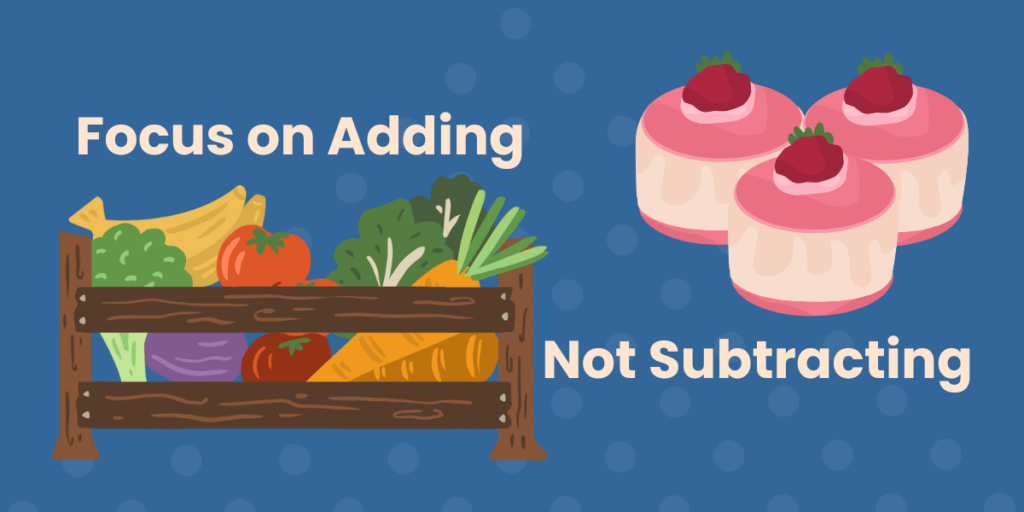
3. Focus on Adding, Not Subtracting
This is where we can focus on adding and not subtracting from our lives. Most people apply this logic to a problem. For example, “I want to avoid treats in the break room.” We are restricting ourselves and using willpower to force ourselves to obey an action. Resist those treats! So we are subtracting from our lives.
Then as the logic continues to focus on the problem, they say that we should add to our diets by including more nutritious foods. I don’t know about you, but I’ve brought fruit to work fully intending to eat healthier. Guess what happens. I still eat the sweets and the fruit starts to rot!
The psychology of abundance vs. restriction
So this psychology was not applied correctly. We should not apply it to the problem itself (the action we hope to change). We should apply this psychology to the core values we hold. “I want to show up for my family being the best version of myself.” Period. Do you know what this value does? Having your value in mind adds to your life, rather than subtracts from your life. You see what you gain rather than what you lose.
Crowding out unhealthy options naturally
If we pit sweet treats against our family, who among us would willingly prioritize that treat? That’s not to say that we would not choose the treat at least sometimes. Of course, the compulsion is great. However, we begin to make decisions centered around aligning with our true values. So we essentially crowd out unhealthy options naturally. We are less likely to choose that sweet treat because being better versions of ourselves is now a competitor. Sometimes this side wins, sometimes that side wins. Our minds are so wonderful that we will naturally make more and more of the decisions that align with our values.
Nutrient-dense foods to incorporate into your diet
When I first started eliminating sweets from my diet, I did not intentionally do so. I would go to the grocery store and view food in a different light. So I naturally gravitated towards the produce section. From there I just let my eyes pick whatever looked good and I took it home. On my next trip to the grocery store, I got used to the layout of the produce section, so I broadened my horizons to include the different meats that were available. Then I saw the nuts and seeds. Next steps were herbs and spices.
With every trip, I began to expand my palate towards whole foods, while refined and packaged foods became more and more uninteresting. So I never exercised any willpower to avoid a certain category of foods. During these trips, if I wanted a certain sweet or if I wanted to try something that looked interesting, or if I wanted to experience the comfort of a familiar food that I know would not contribute to my physical well-being, I would still get it and bring it home. There was no fuss. My cart was already full of foods that align with my values and help me reach my goals.
4. Master the Art of Meal Planning
So I began to plan my meals for sustainable eating. There’s nothing magical here. There’s no special diet. I don’t believe you need a step-by-step guide to effective meal planning. However, everyone should use their strengths to pursue their ultimate goal of further aligning their lives with their core values.
So if you need a step-by-step guide, here is an example of one. Additionally, there are many tools and apps to help you simplify the process and allow you to be more mindful of your eating habits.
Step-by-step guide to effective meal planning
Now, let’s dive a bit deeper into meal planning. It’s not about creating rigid schedules or fancy recipes. It’s about setting yourself up for success. Start small – maybe plan just three dinners for the week. Think about what you enjoy eating, what makes you feel good, and what aligns with your health goals.
A simple approach might look like this: Choose a protein, a vegetable, and a whole grain for each meal. Mix and match these components throughout the week to keep things interesting. Don’t forget to include some healthy fats like avocado, nuts, or olive oil.
Remember, meal planning isn’t just about dinner. Consider your breakfasts, lunches, and snacks too. Prep some overnight oats or hard-boiled eggs for quick breakfasts. Make extra dinner to pack for lunch the next day. Keep cut veggies and hummus on hand for easy snacking.
And here’s a pro tip: always keep a few “emergency” meals in your freezer. These could be homemade soups, stews, or even a healthy frozen meal from the store. This way, on days when your plan falls apart (because life happens), you still have a nutritious option at your fingertips.
The key is to find a system that works for you. Maybe you prefer to prepare everything on Sunday, or perhaps you like to cook a little each day. Whatever you choose, the goal is to make healthy eating the easy choice. With a little practice, meal planning will become second nature, and will power won’t even enter the equation!

5. Practice Mindful Eating
So how do you practice mindful eating? In my opinion, mindful eating begins at the grocery store and ends in the toilet. I know that sounds crude. However, eating doesn’t begin and end when you chew and swallow. Your body has only begun eating to be nourished by the mindful choices that you’ve made thus far. And now you must continue to be mindful of your body’s reactions to the choices you’ve made in order to determine whether or not you should eat that particular food again.
Techniques to increase eating awareness
In my opinion, there are no fancy techniques to increase your eating awareness. All you really need is your power of observation. You can see what you’re choosing at the grocery store and whether or not you feel energized or excited by your choices. As you prepare your meal at home, you can see the process of preparation and cooking, smell the aromas, and feel your mouth water in anticipation of the meal.
When you sit down to eat, do you enjoy the taste? Do you feel this meal has nourished and energized you? Or do you feel sluggish and ready to fall asleep? Finally, when you go to the bathroom, you can feel how it’s going. You can see and certainly smell how the food that you ate was processed inside your body. What gets flushed down the toilet gives you the best idea of how well digestion took place.
Overcoming distractions during meals
In order to observe these steps, you need to overcome distractions. So turn that TV off and put your phone away in order to fully immerse yourself in the experience of food from start to finish.
6. Embrace Cooking as a Life Skill
How cooking contributes to healthier eating habits
I would like to emphasize and encourage you to embrace cooking as a life skill. I’m not very good at it. I’ve definitely burned a few things. However, I find that I have a more intimate relationship with my food if I cook it for myself. Therefore, cooking contributes to healthier eating habits. More importantly, it contributes to my perception of myself with respect to my values.
How did I start? With a crockpot and a frying pan. I made eggs for breakfast and I would throw a bunch of ingredients into the crockpot so that I can come home to a healthy meal after a long, busy day. It may not always have been delicious, but I would always come home looking forward to what I made for myself.
Simple recipes for beginners
Let’s talk about some simple recipes to get you started on your cooking journey. Remember, it’s not about being a gourmet chef – it’s about nourishing your body and enjoying the process.
Breakfast can be as simple as scrambled eggs with some veggies thrown in. Try spinach, tomatoes, or bell peppers. If you’re short on time in the mornings, boiled eggs are a game-changer. I ate 2 or 3 every day with some nuts and seeds to get the protein and healthy fats to energize me for the day.
For those people that may be allergic to eggs and nuts, mix oats with milk (dairy or plant-based), add some fruit and nuts, and let it sit in the fridge overnight. Voila! Breakfast is ready when you wake up.
For lunch and dinner, that crockpot will be your best friend. A basic chili is foolproof – throw in some ground meat (or beans for a vegetarian version), canned tomatoes, onions, and your favorite spices. Let it cook while you’re at work, and come home to a delicious, hearty meal.
Stir-fries are another quick and easy option. Choose your protein (chicken, beef, fish), add whatever veggies you have on hand, and season with soy sauce or your favorite spices.
Meal prep strategies for busy lifestyles
When it comes to meal prep, don’t overwhelm yourself. Start by prepping components rather than full meals. Cook a big batch of grains, roast some vegetables, and grill some chicken at the start of the week. Then mix and match these components for various meals throughout the week.
Remember, cooking is a skill that improves with practice. Don’t be discouraged if things don’t turn out perfect at first. Each time you cook, you’re learning and getting better. Plus, you’re taking control of your health and aligning with your values. That is a point of pride for me!
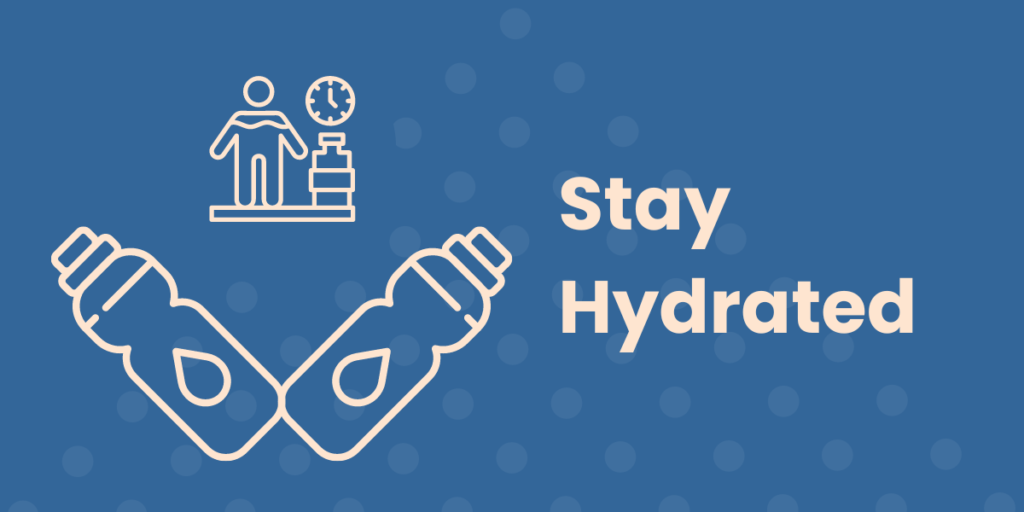
7. Stay Hydrated
Here I have to say something about staying hydrated. I can go all day at work without eating. I might be a little grumpy at the end of the day, but that’s nothing compared to going all day without drinking water.
Importance of hydration for overall health
I cannot overstate the importance of hydration for my own overall health, because my mood tanks if I’m dehydrated. By the time I get home from a day of no water, I need to drink 2 L of water and wait two to three hours before my mood begins to lift.
Creative ways to increase water intake
Therefore, I firmly believe that the number one health hack for human beings on planet earth is to drink plenty of water. So I always bring my water bottle and I always find out where the water fountain is to refill. Of course, I always find out where the bathroom is to empty the tank whenever necessary. A minor inconvenience because hydration is non-negotiable for me. I need to stay hydrated in order to stay at my best self.
I know this about myself because of my powers of self-observation. I use what I observe and know about my strengths to help me make decisions that align with my values. There’s always experimentation involved at first; but once I’m dialed in, it’s all good.
Understanding hunger vs. thirst cues
Staying hydrated also helps me understand whether or not I’m actually hungry or thirsty. The hunger and thirst signals are located in the same small area in the brain called the hypothalamus. So setting off a hunger signal can actually mean that you’re thirsty and vice versa. My favorite way to tell the difference is to drink a glass of water when I feel hungry. If I still feel hungry after 10 or 20 minutes, then I know I should probably eat something.
8. Build a Supportive Environment
Surrounding yourself with positive influences
So basically the lesson here is to know your environment and make small changes to adjust accordingly. Find the water fountain and find the bathroom. Then bring your water bottle. Another way to build a supportive environment is at home. Organizing your kitchen for success and surrounding yourself with positive influences help make food decisions easier.
Organizing your kitchen for success
There’s a wonderful book called “Atomic Habits” by James Clear. He mentions that in order to make the decisions you want to make, you have to make those decisions easier than the ones you don’t want to make anymore. One example of this is to stock your fridge and cabinets with wholesome foods that are easily accessible. On the flip side, sweets, treats, and other processed foods must be stored somewhere that is not easily accessible. Therefore you are forced to go the extra mile whenever you want to get them.
Dealing with unsupportive friends or family
This strategy could help if you live alone or live with friends and family who are supportive of your decisions and want to take part in this health-conscious approach. But what about dealing with unsupportive friends or family?
That’s a hard one I have not figured out yet. We must at least acknowledge that each of us has a right to make decisions for ourselves. Therefore we can simply explain why we choose our path and that we would appreciate their support. We cannot thrust our decisions upon others. Furthermore, if we intrinsically know that this path aligns with our own values, then we ultimately do not need another’s support. We have the drive within ourselves to proceed according to plan.
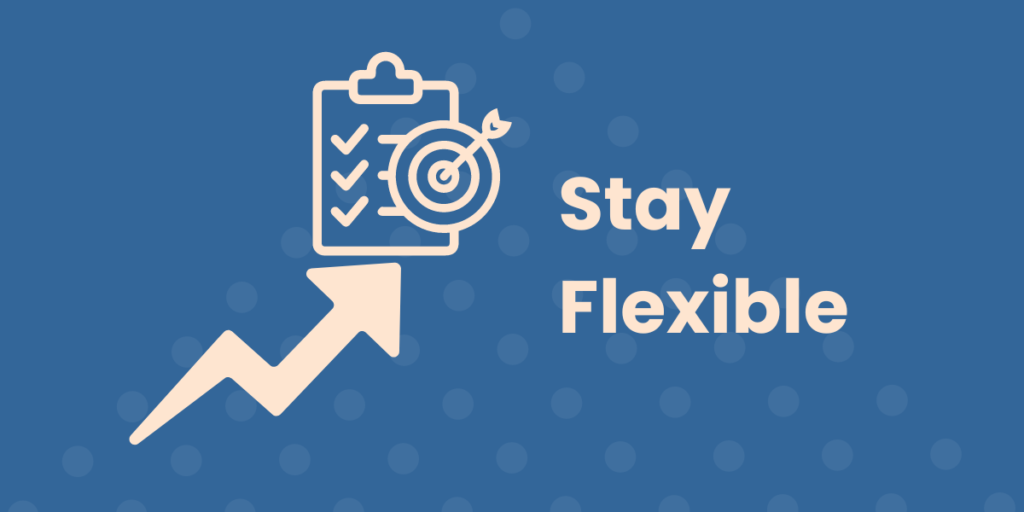
9. Allow for Flexibility and Treats
That is not to say that you cannot allow for flexibility and treats; or that you cannot enjoy the companionship of your family during dinner. Again, we go back to mindful awareness of what we eat and why.
The 80/20 rule in sustainable eating
The 80/20 rule is a strategy that most people know to help aid with sustainable eating. It’s a nice guideline, but truth be told, I sometimes do 70/30, 60/40, 50/50, or worse. However, I think the main idea is that every day requires its own balance. So work toward finding the right balance for you.
Mindful indulgence without guilt
There are many great ideas out there about how to maintain healthy eating and adequate nutrition regardless of unique circumstances. I’ve certainly enjoyed a Las Vegas buffet or two! However, I think the best approach is to maintain mindfulness. If I see a buffet of desserts, then you better believe I’m going to enjoy every offering without guilt. Why? Because I know I don’t do this every day and because I know that I consistently eat well.
Diving a bit deeper into this idea of mindful indulgence. It’s not about perfection; it’s about balance and enjoyment. When you do decide to have a treat, really savor it. Use all your senses. Notice the texture, the flavor, the aroma. Eat it slowly and deliberately. This mindful approach often leads to greater satisfaction with smaller portions.
Strategies to get back on track after slip-ups
However, if you do have one of these slip-ups, the best way to get back on track is to not consider it a slip-up. You fully enjoyed a human experience. The only thing to do now is to resume alignment with your values. So there’s no need to feel defeated or disappointed.
Remember, food is not just fuel – it’s also a source of pleasure and social connection. So when you’re at a birthday party or a holiday gathering, allow yourself to partake in the celebration. The key is to do so consciously, not mindlessly.
Now, let’s talk about getting back on track after an indulgence. First, ditch the guilt. Guilt often leads to a “what the heck” mentality, where you think, “Well, I’ve already messed up, so I might as well keep going.” Instead, view each meal as a fresh start. Had a big slice of cake at lunch? That’s okay. You will naturally gravitate to more nourishing options for your next meal.
A practical tip: always have a “next day” plan. After a day of indulgence, plan a day of nourishing, whole foods. Stock up on fresh fruits and veggies, lean proteins, and whole grains. Prepare a big salad or a veggie-packed soup. This isn’t about restriction or punishment – it’s about caring for your body and getting back to your usual, feel-good eating habits.
Remember, sustainable eating is about the long game. One day of overindulgence doesn’t negate weeks or months of healthy habits. Trust in the foundation you’ve built and know that you can always come back to it. This flexibility and self-trust are what make your healthy eating truly sustainable.
10. Track Progress and Celebrate Small Wins
Non-scale victories in sustainable eating
You just continue to track progress and celebrate small wins. Small wins can take many different forms. For example, you can feel like you have more energy. You might feel well rested after getting better quality sleep. Your clothes would fit better. You may have enhanced mood and mental clarity. These things all help track your progress in small wins subjectively.
Apps and tools for progress tracking
You can also track your small wins objectively with apps and tools. I tend to use a habit tracker. That way every time I complete a habit for the day I check it off the list. I know it’s done and I feel good that I actually accomplished something that leads me towards my health for today.
Importance of self-compassion in the journey
I don’t always hit my mark, however this is where the importance of self-compassion comes in. You must treat yourself with kindness and understanding. We are not robots or machines. We are all human. Change is going to take time. We’re all going to experience setbacks and struggle to succeed. So when I say to celebrate your small wins, I mean to celebrate your efforts and not the outcomes.
Conclusion – Sustainable Eating Habits
Congratulations!
You have come so far!
You’re now armed with 10 powerful steps to build sustainable eating habits that will serve you well beyond 2024.
Remember, this journey is a marathon, not a sprint. Be patient with yourself, celebrate every small victory, and most importantly, enjoy the process of nourishing your body.
The path to lasting health is paved with sustainable choices, not quick fixes.
Remember, sustainable eating isn’t just about the food on your plate – it’s about nurturing your body, mind, and spirit.
Here’s to your health, happiness, and a future filled with delicious, nourishing meals!

